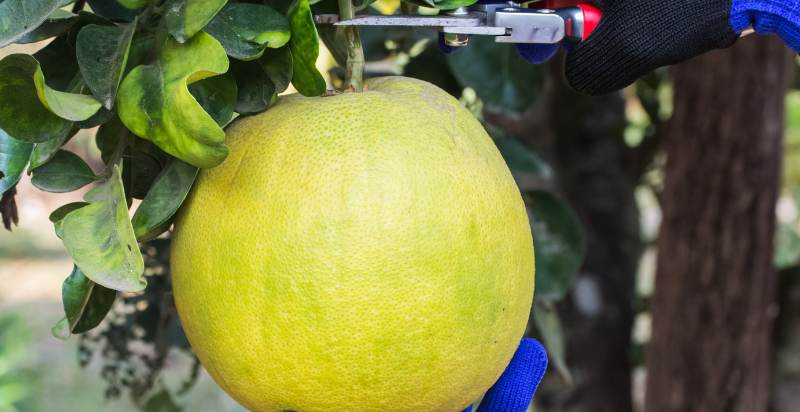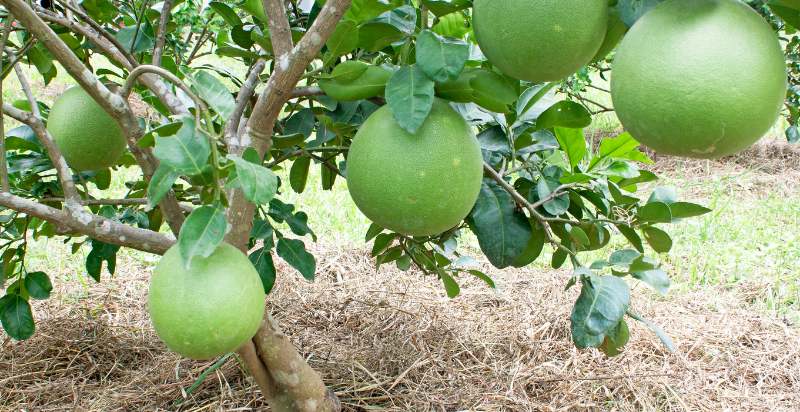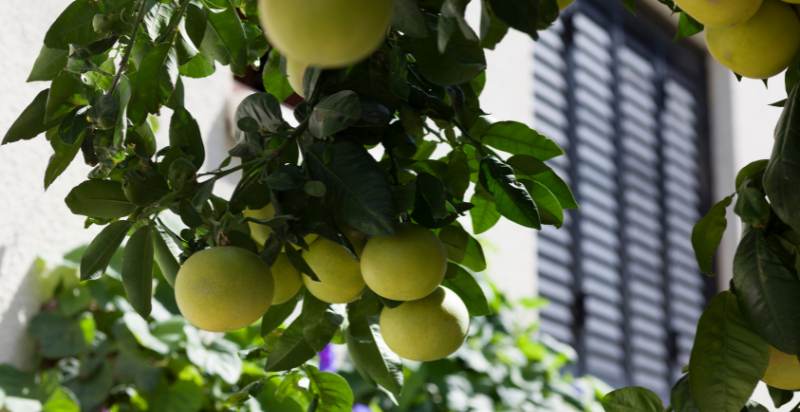Grapefruit is a citrus fruit hybrid of the sweet orange and the pomelo. It has been cultivated in many parts of the world for centuries, but it wasn’t until the 1800s that its popularity took off. Grapefruit comes in various colors, including white, pink, red, and yellow. It has a tart flavor and can be eaten alone or used to make marmalades, jams, and jellies. Here’s everything you need to know about Grapefruit and how it can benefit your health.
What is Grapefruit?
Grapefruit (Citrus × paradisi) is a large, round citrus fruit with thick yellow or pink skin. It has many seeds inside and an edible white to pink flesh. Grapefruits vary in size, with some being as small as orange and others reaching the size of a grapefruit. The outer skin can be peeled off easily; inside, it is divided into segments filled with juicy pulp.

Size:
The grapefruit tree can vary in height and size depending on the variety and growing conditions, but on average, it reaches about 15 to 20 feet tall in a home garden setting.
Some varieties can grow taller, up to 30 feet or more, especially in optimal conditions and when fully mature. The tree’s canopy can spread widely, roughly equal to its height, making it a substantial and attractive addition to the landscape.
Lifespan:
Grapefruit trees, when properly cared for, can have a long and productive lifespan. On average, a grapefruit tree can live and bear fruit for 30 to 50 years. Some well-maintained trees in ideal conditions have been known to live longer, even up to 80 years or more, continuing to produce fruit well into their old age. The key to achieving such longevity includes proper planting, consistent care, adequate watering, appropriate fertilization, and effective pest and disease management. Regular pruning and maintenance can also help extend a grapefruit tree’s life by keeping it healthy and productive.
History and Origin
The history and origin of the grapefruit are unclear, but it is believed to have originated in Jamaica sometime around the 17th century. Some say it was an accidental hybridization between a sweet orange and a pomelo. In contrast, others suggest that it may have been created by a reverse cross-breeding of sweet orange with a shaddock (a type of citrus native to the Caribbean).
Regardless of where and how grapefruit came to be, it has become one of the most popular fruits worldwide. It was first introduced into North America in 1823 when James Macfayden planted seedlings on his property near Charleston, South Carolina. From there, cultivation spread throughout Florida and other parts of the United States in the late 19th century.
The grapefruit is a relatively recent addition to Western cuisine. It was largely established in popularity during World War II when it became a staple food for American soldiers stationed in the Caribbean. In 1947, canned grapefruit juice was introduced, and the production of frozen concentrate soon followed.
Today, grapefruits are grown in warm climates throughout the world. California produces more than 80 percent of all fresh-marketed grapefruits in the United States, but Texas and Florida also produce large amounts.
Varieties of Grapefruit
Grapefruit is a citrus fruit known for its tangy and sweet flavor. There are many varieties of grapefruit, each with its unique flavor and characteristics. Some of the most popular varieties include:
- White Grapefruit – this variety has a sweeter taste than other types of grapefruit, making it a great choice for those looking to add some sweetness to their breakfast or snack. White grapefruits also tend to be less acidic than other grapefruits, making them easier to digest.
- Pink Grapefruit – this variety has a slightly tart flavor that still has some sweetness. Pink grapefruits tend to be larger than white grapefruits and have an orange-ish red color.
- Ruby Red Grapefruit – this variety has a strong sweet, and tart flavor, making it a great choice for those who like bolder tastes. Ruby red grapefruits are larger than white or pink varieties and have a deep red hue.
No matter what type of grapefruit you prefer, it’s sure to add some delicious flavor to your meals! Grapefruit is packed with many health benefits, such as providing your body with essential vitamins and minerals, aiding digestion, and helping boost your immune system. So why give grapefruit a try today? Your taste buds will thank you!
Nutritional Value
Grapefruit is an incredibly nutritious and versatile fruit. It contains vitamins and minerals, including vitamin C, potassium, magnesium, calcium, and folate. It contains antioxidants that help protect against cell damage caused by environmental toxins and can even lower cholesterol levels. In many recipes, the natural sugars in grapefruit make it a great substitute for processed sweeteners. And its tart flavor makes it a great addition to salads or drinks.
Grapefruits are high in fiber, which helps keep you feeling full longer and aids digestion. Fiber also helps regulate blood sugar levels, reducing the risk of diabetes. Studies have shown that eating grapefruits may reduce the risk of some cancers due to their high antioxidant content. Grapefruits are also low in calories, making them a great snack or meal replacement.
Grapefruits are an excellent source of vitamin C, which helps support immune system health and keep skin looking young and healthy. Vitamin C helps your body absorb iron from red meat, beans, and spinach. It also plays a role in wound healing, fighting infection, and maintaining healthy blood vessels.
Grapefruits contain potassium, which is important for keeping blood pressure levels normal and controlling heart rate. Potassium also helps support strong bones by helping to regulate the balance of calcium and phosphorus in your body.
Finally, grapefruits contain water-soluble pectin fibers, which can help reduce cholesterol levels. Pectin can also help slow digestion, making you feel fuller and longer and helping to prevent overeating.
All in all, grapefruits are a great source of nutrition and make a delicious snack or addition to any meal! Whether you enjoy them plain or in a recipe, they’re sure to add tasty nutrition to your day.
What are the Uses
Grapefruits are incredibly versatile fruits that can be used in various ways. The most popular use for grapefruits is as a breakfast fruit. Grapefruit halves can be cut and eaten with a spoon or juiced to make an antioxidant-rich, refreshing drink.
Grapefruit juice can also be used in cooking, adding a sweet and tart flavor to many dishes. Grapefruits are especially good for making marmalades and sorbets due to their high pectin content. Many people also enjoy using grapefruit zest in baking, which adds a pleasant citrusy flavor.
In addition to being excellent sources of nutrition, grapefruits are also very therapeutic. In folklore, they have been used to treat various illnesses, such as colds, flu, and even asthma.
Understanding the Flowering and Fruiting Process
Grapefruit trees usually flower in the spring, with the blossoms developing into fruit that will mature over several months. The fruiting cycle from blossom to ripe fruit generally takes about 7 to 9 months, depending on the climate and variety. Grapefruit trees can produce a large number of flowers, but not all flowers will turn into fruit. The tree naturally drops some of the developing fruit to ensure that the remaining ones grow to a healthy size.
How to Plant Grapefruit
Grapefruit is a delicious, healthy citrus fruit that grows in warm climates and can be planted in home gardens with proper preparation. Planting grapefruit tree can be a rewarding experience, not only because you enjoy the sweet fruit but also because it adds beauty and lushness to your yard. This article will explain everything you need to know about how to plant grapefruit for a successful harvest.
Preparing the Soil:
The most important factor when planting grapefruit tree is the soil quality. Before planting anything in your garden, you must check the soil’s pH level to ensure it falls between 5.5 and 7.0, as this is ideal for growing grapefruit trees. If necessary, soil additives can be added to adjust the pH levels. Good drainage is also essential for grapefruit tree, as they do not like wet feet.
Selecting:
Once you have checked the soil content and are ready to begin planting, it is important to choose high-quality grapefruit tree. Look for disease-resistant varieties that are hardy in your region and have been grown in similar climates. Also, select a variety that produces sweet fruit instead of tart fruit.
Planting:
When planting grapefruit trees, you should start digging a hole twice as wide and just as deep as the root ball of your tree. Ensure good drainage is around the hole, and add some compost or organic matter. Place the tree in the hole, backfill it with soil, and tamp it down firmly, so there are no air pockets. Water the area to settle the soil around the root ball before adding a layer of mulch to help retain moisture.
How to Care for and Grow Grapefruit
Grapefruit is a citrus fruit that is full of vitamins, minerals, and antioxidants. It’s an excellent source of Vitamin C, which helps protect your cells from damage caused by free radicals. When it comes to growing grapefruit, you should keep a few things in mind. Here are some tips on how to care for and grow grapefruit:
- Location – Grapefruit need plenty of suns to ripen properly, so choose a spot with at least 6-8 hours of sunlight each day. Avoid areas with heavy winds or frosty conditions, as these can cause the fruit to become deformed or split open prematurely.
- Soil – Grapefruit tree prefers soil that is light and well-drained. Be sure to add plenty of organic matter when planting your grapefruit trees, as this will help to provide the necessary nutrients for the tree and ensure quality fruit production.
- Water – Grapefruit tree needs a consistent water supply to stay healthy and produce sweet, juicy fruit. The soil should be moist but not soggy, with regular watering throughout the growing season. During periods of drought, give your grapefruit trees extra water to keep them from wilting or drying out completely.
- Fertilizing – To maintain a healthy growth rate and abundant fruit production, it is important to fertilize your grapefruit tree regularly throughout the year with an all-purpose fertilizer. The best time to fertilize is in the spring, just before bud break.
- Pruning – Pruning your grapefruit tree is important for keeping them healthy and producing good quality fruit. It’s best to prune in the late winter or early spring when the tree is still dormant. This will help keep it from becoming overgrown and ensure enough leaves and branches for proper air circulation, which helps minimize disease problems.
These tips will help you grow vibrant and healthy grapefruit trees that produce sweet, juicy fruit each year! With a little care, you can enjoy the delicious taste of home-grown grapefruit!

Preventions from Pests and Diseases
Grapefruit is an excellent source of vitamins, minerals, and antioxidants. However, it can also be susceptible to certain pests and diseases. To protect this tasty fruit from these unwanted guests, it is important to take preventive measures such as proper cultivation techniques, pest control products, and regular inspections.
Cultivation techniques such as crop rotation, where fruits are planted in different locations each year to keep diseases from spreading too easily, can be employed for grapefruit. Additionally, good sanitation practices, like removing dead or dying plant material, can help reduce pest infestations.
Pest control products like insecticides and fungicides should be used cautiously when dealing with grapefruit crops. These chemicals should only be used if necessary, as too much use can harm beneficial insects and pollinators that help keep pests and diseases in check.
Finally, regular inspections of the grapefruit crop are also important for prevention. These should include scouting for any pests or diseases present, checking for signs of damage, looking out for nutrient deficiencies, and inspecting the foliage to ensure it is healthy.
Following these preventive measures ensures that your grapefruit crop remains safe from pests and diseases. With extra effort and care put into cultivation techniques, pest control products, and regular inspections, your grapefruit crop can remain in excellent condition throughout the growing season!

How to Harvest
Harvesting grapefruit is a simple process. Start by looking for the ripe fruit with a bright yellowish-orange hue and fragrant aroma. The ideal grapefruit should be slightly soft to the touch, indicating that it has reached full maturity. Depending on the variety of grapefruit you are harvesting, they can range in size from small to large. Select larger varieties if you plan on keeping your harvest for an extended period.
When picking your grapefruit off the tree, use a pair of garden or pruning shears if available. Cut just below where the stem attaches to the branch and ensure that some stems remain attached to avoid damaging nearby branches. If you do not have access to these tools, use your hands to pull the fruit away from the tree gently.
Once harvested, it is best to store grapefruit in a cool and dry place such as a refrigerator or pantry. This will help preserve their flavor for longer periods. You can also freeze freshly picked grapefruit for up to six months without noticeable flavor or texture changes.
It’s important to note that when harvesting grapefruit, it is best practice not to damage the tree or surrounding branches. Use appropriate tools and techniques when picking fruit off the tree to ensure healthy growth for the tree and your crop!
Temperature Tolerance of Grapefruit Trees
Grapefruit trees are subtropical plants and prefer warm climates. They can tolerate temperatures as low as 26-28°F (-3 to -2°C) for short periods, but young trees are more susceptible to cold damage. Frost and freezing temperatures can damage or kill the tree and its fruit. To protect grapefruit trees in cooler climates:
- Plant in a Sheltered Location: Choose a site that’s protected from cold winds and frost pockets, such as near a south-facing wall.
- Use Frost Protection: Cover young trees with frost cloth or blankets when freezing temperatures are forecasted. Use string lights (not LED) under the cover for added warmth.
- Mulch: Apply a thick layer of mulch around the base of the tree to insulate the roots from cold temperatures.
Grapefruit trees thrive in temperatures ranging from 70°F to 90°F (21°C to 32°C) and require plenty of sunlight for optimal growth and fruit production. In regions with cooler climates, they can be grown in large containers and moved indoors or to a protected area during colder months.
How to Store Homegrown Grapefruit
Storing homegrown grapefruit is a great way to preserve its freshness and flavor. There are several methods you can use to store your grapefruit, depending on how long you plan to keep it.
If you plan on consuming the fruit within two weeks, it can be stored in the refrigerator without additional preparation. Ensure that your fridge temperature is set between 41-50 degrees Fahrenheit (5-10 degrees Celsius). You can also store grapefruit at room temperature if you plan to eat it sooner; however, this will cause it to ripen faster than if it was stored refrigerated.
If you have more than one grapefruit variety, store them separately so they don’t mix flavors. Packed in a single layer, grapefruit can be stored in the refrigerator for up to four weeks without losing its flavor or texture. If you plan on storing it longer than that, it’s best to freeze the fruit instead.
To freeze grapefruit, ensure your freezer is set at 0 degrees Fahrenheit (-17 degrees Celsius), and then blanch the fruit by boiling it in hot water for two minutes and immersing it in cold water afterward. Peel off the skin and remove the pith before cutting the fruit into cubes or slices and freezing them in an airtight container or bag. This will help preserve their flavor and texture for up to 6 months.
You can also store grapefruit in jams, jellies, and marmalades – these will last for weeks or even months without refrigeration. Prepare and can your favorite recipes as you normally would before storing them in a cool and dry place.
No matter which method you choose to store your homegrown grapefruit, it’s important to maintain proper food safety guidelines by keeping the fruit away from heat sources and eating or freezing it within two days of picking it. By doing so, you can enjoy its freshness for weeks or even months longer!

How to use Homegrown Grapefruit in your day-to-day life?
Grapefruit is a highly nutritious and versatile citrus fruit that can be enjoyed in many ways. From breakfast to dinner, and even snacks in between, grapefruit has the potential to add flavor and nutrition to your meals. Here are some ideas on how you can use homegrown grapefruit in your day-to-day life:
- Start your morning with a fresh grapefruit juice or smoothie. You can combine it with other fruits for an extra nutritional boost, or enjoy it pure!
- Top salads with wedges of freshly cut grapefruit for a sweet and tangy flavor. Grapefruit is also great as part of a salad dressing thanks to its tartness.
- Make a refreshing summer salsa with diced grapefruit, jalapenos, and cilantro. Serve it with chips or as a topping for grilled fish tacos.
- Incorporate some flavor into your snacks by slicing a grapefruit and sprinkling it with cinnamon or nutmeg. You can also dip the slices in melted chocolate for an after-dinner treat.
- Broil grapefruit slices with a sprinkle of sugar and cinnamon for a quick dessert at the end of the day.
Using homegrown grapefruit in your day-to-day life is an easy way to add flavor, nutrition, and variety to meals. Enjoy this sweet and tart fruit in all its forms!

Potential Risks from Grapefruit in your day-to-day life
Grapefruit can be a healthy and delicious addition to your daily diet, but some potential risks are associated with consuming it. The most significant one is that grapefruit can interact with certain medications, decreasing or increasing their effectiveness. This includes common drugs such as statins (used to lower cholesterol), blood pressure medications, antidepressants, anti-anxiety medications, and immunosuppressive medications used for cancer treatment. Grapefruit also increases the risk of kidney stones in people with pre-existing conditions, increasing their likelihood of developing them. Lastly, eating too much grapefruit can lead to digestive upset due to its high acid content.
For those taking prescription medications, it is important to speak with your doctor or pharmacist about potential interactions between grapefruit and your medication. Eating one to two servings of grapefruit per day is considered safe for those without medical conditions.
It is important to note that some other citrus fruits can also interact with medications similarly, so be sure to check with your doctor before consuming them. Additionally, it’s best to avoid grapefruit juice when taking prescription medications, as the concentration of active ingredients is higher than in the fruit itself. So enjoy this tasty and healthy fruit but do so safely by consulting your healthcare provider first!
Conclusion
Homegrown grapefruit is a delicious, nutritious, and versatile fruit that can be enjoyed year-round. From its use in recipes to simply snackin on it straight from the tree, this sweet and tart citrus fruit offers numerous benefits for your health. However, if you are taking any prescription medications, you must check with your doctor or pharmacist about potential interactions between grapefruit and your medications. Enjoy the taste of homegrown grapefruit safely!
Properly storing and using homegrown grapefruit in your daily life can reap its nutritional benefits while avoiding any potential risks associated with consuming it. With just a little knowledge and preparation, you can enjoy the sweet flavor of homegrown grapefruit all year long!
P.S. Please follow all safety guidelines when handling homegrown produce, as improper storage and preparation can lead to foodborne illness. Be safe and enjoy the taste of fresh grapefruit!
Frequently Asked Questions
How long does it take for grapefruit trees to bear fruit?
Grapefruit trees typically begin to bear fruit when they are about 3 to 6 years old if grown from a grafted sapling. Trees grown from seed may take a bit longer, usually around 7 to 8 years, before they start producing fruit. The exact time can vary based on the tree’s growing conditions, care, and variety.
Are grapefruit trees male or female?
Grapefruit trees are self-fertile, meaning they have both male and female reproductive organs in the same flower. This allows a single grapefruit tree to produce fruit on its own without the need for a second tree to provide cross-pollination. However, having more than one tree can sometimes increase yield through cross-pollination, especially in varieties that are not as self-fertile.
- Everything You Wanted to Know About Red Tamarillos - June 2, 2025
- A Guide to Tulips: Everything You Need to Know & More… - June 2, 2025
- Guanabana: Description, Flavor, Benefits, And Uses - May 27, 2025

11 thoughts on “How to Plant, Grow, and Harvest Grapefruit”
Comments are closed.